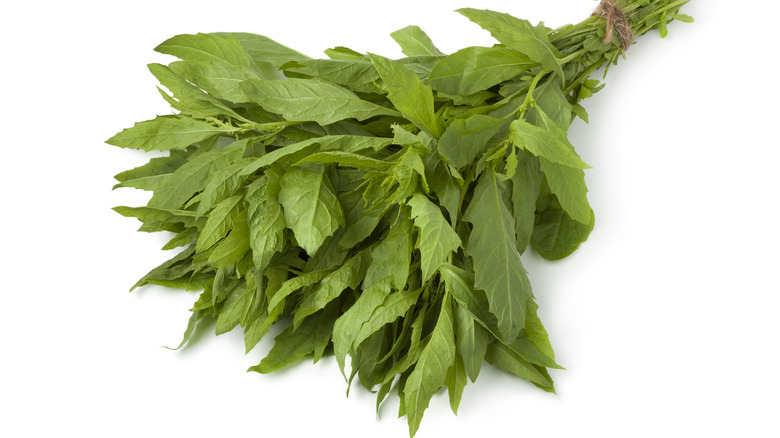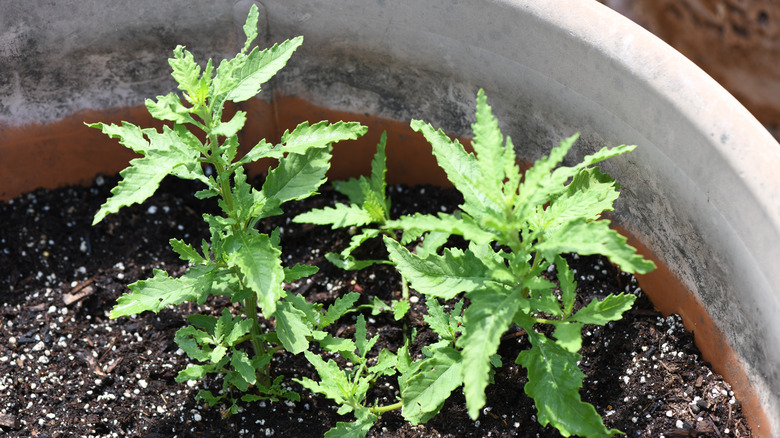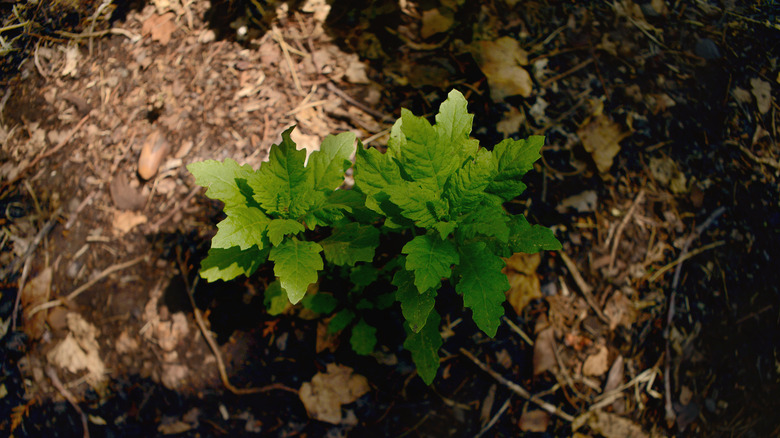Epazote: The Mexican Herb You Should Be Adding To Beans
Sometimes the most exciting flavors are blooming right in the backyard. Whether plucked from a homegrown garden, snipped off of a neighborhood rosemary bush, or foraged in a local forest, there are many tasty alternatives to grocery store shopping. Cooking with plants straight from the ground comes with many benefits. Not only does it save costs, but the flavor is more pungent than many store-bought alternatives, reports Auguste Escoffier.
For a flavorful herb that's easy to grow, turn to epazote, which is native to South and Central America. Sprouting in nearly any condition, the plant is so resilient it's sometimes considered a weed. Consumed since early Mayan times, it continues to be a component of Latin American cuisine, especially in bean dishes. Used in parallel for medicinal purposes, specifically stomach ailments, this common-growing herb makes for an excellent garden addition, per U.S Botanic Garden. Let's unpack this tasty Mexican plant.
What is epazote?
Dysphania ambrosioides, referred to as Mexican Tea, wormseed, and most commonly epazote, is a two to four feet tall plant with tooth-shaped leaves. Due to its strong smell and taste, the name comes from the Nahuatl word for skunk, but the flavor is much more palatable — similar to anise or licorice. A staple in Mexican cuisine, the entire stem and leaves are added to moles and black beans for an earthy, comforting flavor, via Maine Organic Farmers and Gardeners.
This plant grows very easily. According to Aggie Horticulture, epazote is found ubiquitously in urban environments, including in parks and pavement cracks across Texas and Mexico. Long esteemed for its parasitic-expelling qualities (hence the name wormseed), its oil used to be extracted for medical applications. Research demonstrated the extract is highly toxic, especially for children, so now the herb is only utilized unprocessed, reports the University of Texas at El Paso. Epazote's rich flavor is its prime characteristic — here's how to cook with it.
How to cook with epazote
Due to its strong, eucalyptus-like flavor, it's best to use epazote sparingly. Try cooking with only one leaf to start. Epazote's flavor dissipates with heat, so add the entire stem and leaves near the end of the cooking process. Perfect in beans, its most well-known application, or in stews like pozole, the plant adds a comforting earthy element via The Spruce Eats. Also readily available dried, the dehydrated form is less aromatic, making it an easier, more versatile addition. Epazote can be sprinkled into quesadillas, added to bean-filled sopes, or even as an additional flavor in a corn salad. While tarragon or oregano can be used as a substitute, the distinct flavor of epazote is hard to replicate, reports SBS.
When shopping for epazote, it's okay to buy leaves on the wilted side because the flavor is unaffected. It is important to store it vertically propped in a vase of water like a flower bouquet or wrapped in a dampened paper towel, and kept in a plastic bag in the fridge, notes Rick Bayless.
Where to get epazote
Before better antiparasitic medication was developed, epazote was grown in large quantities in the U.S. As a result, the plant is more ubiquitous in garden settings than many realize. The seeds are easy to procure, and epazote integrates well with other plants. Since epazote draws wasps and flies, it can protect more delicate neighbors. Epazote flourishes in diverse soils, only requiring some sun to thrive. It easily dries for later use and can be stored in an air-tight container for long periods. As a result, to those with a home garden, growing it is the best way to get it into the kitchen, per Gardener's Path.
For purchase, look for epazote at local international grocery stores, where it may be found in fresh form and frequently in a dried state, explains SBS. Dried epazote can also be purchased online. The raw plant is also becoming increasingly popular at farmers markets and local grocers. Don't hesitate to buy a bundle — it'll add a delectable earthy note to beans and other Mexican dishes.



